Family Health Case Study Essay: NURS20029, Avondale University
VerifiedAdded on 2022/10/02
|12
|2981
|339
Essay
AI Summary
This essay, prepared for the NURS20029 Family Health unit at Avondale University, examines the case of a patient, Mei, diagnosed with pneumonia, and explores the broad implications of family health. The essay begins with an introduction to the topic, followed by a detailed overview of pneumonia, including its aetiology, pathophysiology, diagnosis, and medical treatment. It then delves into the holistic impacts of the condition on the patient and her family, emphasizing the importance of partnerships of care between the patient, family, and nurses. The discussion also includes a justification for holistic care within the context of the case. Furthermore, the essay identifies nursing activities and community resources available to support the family. The essay highlights the crucial role of community healthcare, emphasizing the importance of reaching out to community health services to meet the family's needs. The conclusion summarizes the key findings, reinforcing the value of a holistic approach to family healthcare.
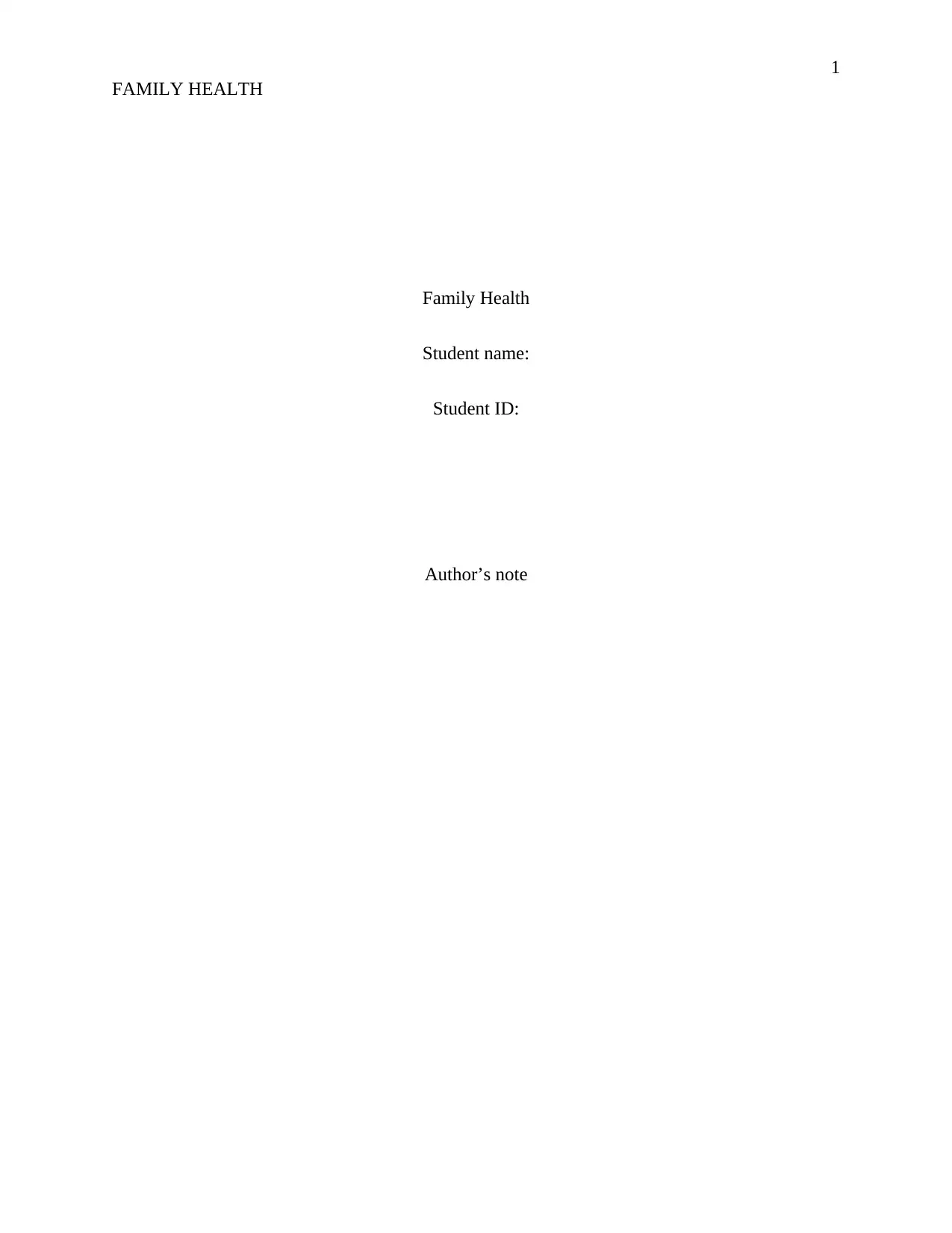
1
FAMILY HEALTH
Family Health
Student name:
Student ID:
Author’s note
FAMILY HEALTH
Family Health
Student name:
Student ID:
Author’s note
Paraphrase This Document
Need a fresh take? Get an instant paraphrase of this document with our AI Paraphraser

2
FAMILY HEALTH
Table of Contents
Introduction......................................................................................................................................2
Brief overview of the condition (aetiology, pathophysiology, diagnosis, and medical treatment). 2
Holistic impacts & partnerships of care...........................................................................................4
Justification of holistic care and partnership...................................................................................6
Nursing activities and community resources...................................................................................7
Conclusion.......................................................................................................................................7
Reference.........................................................................................................................................9
FAMILY HEALTH
Table of Contents
Introduction......................................................................................................................................2
Brief overview of the condition (aetiology, pathophysiology, diagnosis, and medical treatment). 2
Holistic impacts & partnerships of care...........................................................................................4
Justification of holistic care and partnership...................................................................................6
Nursing activities and community resources...................................................................................7
Conclusion.......................................................................................................................................7
Reference.........................................................................................................................................9

3
FAMILY HEALTH
Introduction
The case study focuses on the impact of health of an individual with special reference to
community. The term family health is a diverse topic and is currently receiving increasing
attention from diverse disciplines. Nevertheless, the importance of family health cannot be
neglected. Knowing the family history can work on reducing the risks of developing health
problems. Since family members share same lifestyle and even habits risk for certain diseases
can be rightly mitigated through family healthcare mitigation. The assignment therefore works
on finding the exact cause, pathophysiology and even treatment for the disease. In addition to
that the nursing intervention and help at community level is discussed
Brief overview of the condition (aetiology, pathophysiology, diagnosis, and medical
treatment)
Aetiology
These days’ measles is accompanied by severe body temperature and forms of
pneumonia that relative immunity of children to empyema is difficult to explain. The argument
that measles exhibits no tendency to lead to formation of purulent (Zamanzadeh et al. 2015).
However, such evidence fails to support the observed frequency that exudates amongst adult
individuals. Haemolytic streptococci are found with high influence than any other group of
organism; pneumococci being more prevalent in primary forms of broncho-pneumonia.
Pneumococcal pneumonia in case of measles is exhibited as a result from virulence of harmless
saprophytes within the nasopharynx area. As pointed out by Jasemi, Valizadeh, Zamanzadeh &
Keogh (2017), saprophytes in nasopharynx area are less liable to give out purulent effusions, as
compared with type I and II of pneumococci strain. In addition to that some young children like
FAMILY HEALTH
Introduction
The case study focuses on the impact of health of an individual with special reference to
community. The term family health is a diverse topic and is currently receiving increasing
attention from diverse disciplines. Nevertheless, the importance of family health cannot be
neglected. Knowing the family history can work on reducing the risks of developing health
problems. Since family members share same lifestyle and even habits risk for certain diseases
can be rightly mitigated through family healthcare mitigation. The assignment therefore works
on finding the exact cause, pathophysiology and even treatment for the disease. In addition to
that the nursing intervention and help at community level is discussed
Brief overview of the condition (aetiology, pathophysiology, diagnosis, and medical
treatment)
Aetiology
These days’ measles is accompanied by severe body temperature and forms of
pneumonia that relative immunity of children to empyema is difficult to explain. The argument
that measles exhibits no tendency to lead to formation of purulent (Zamanzadeh et al. 2015).
However, such evidence fails to support the observed frequency that exudates amongst adult
individuals. Haemolytic streptococci are found with high influence than any other group of
organism; pneumococci being more prevalent in primary forms of broncho-pneumonia.
Pneumococcal pneumonia in case of measles is exhibited as a result from virulence of harmless
saprophytes within the nasopharynx area. As pointed out by Jasemi, Valizadeh, Zamanzadeh &
Keogh (2017), saprophytes in nasopharynx area are less liable to give out purulent effusions, as
compared with type I and II of pneumococci strain. In addition to that some young children like
⊘ This is a preview!⊘
Do you want full access?
Subscribe today to unlock all pages.

Trusted by 1+ million students worldwide
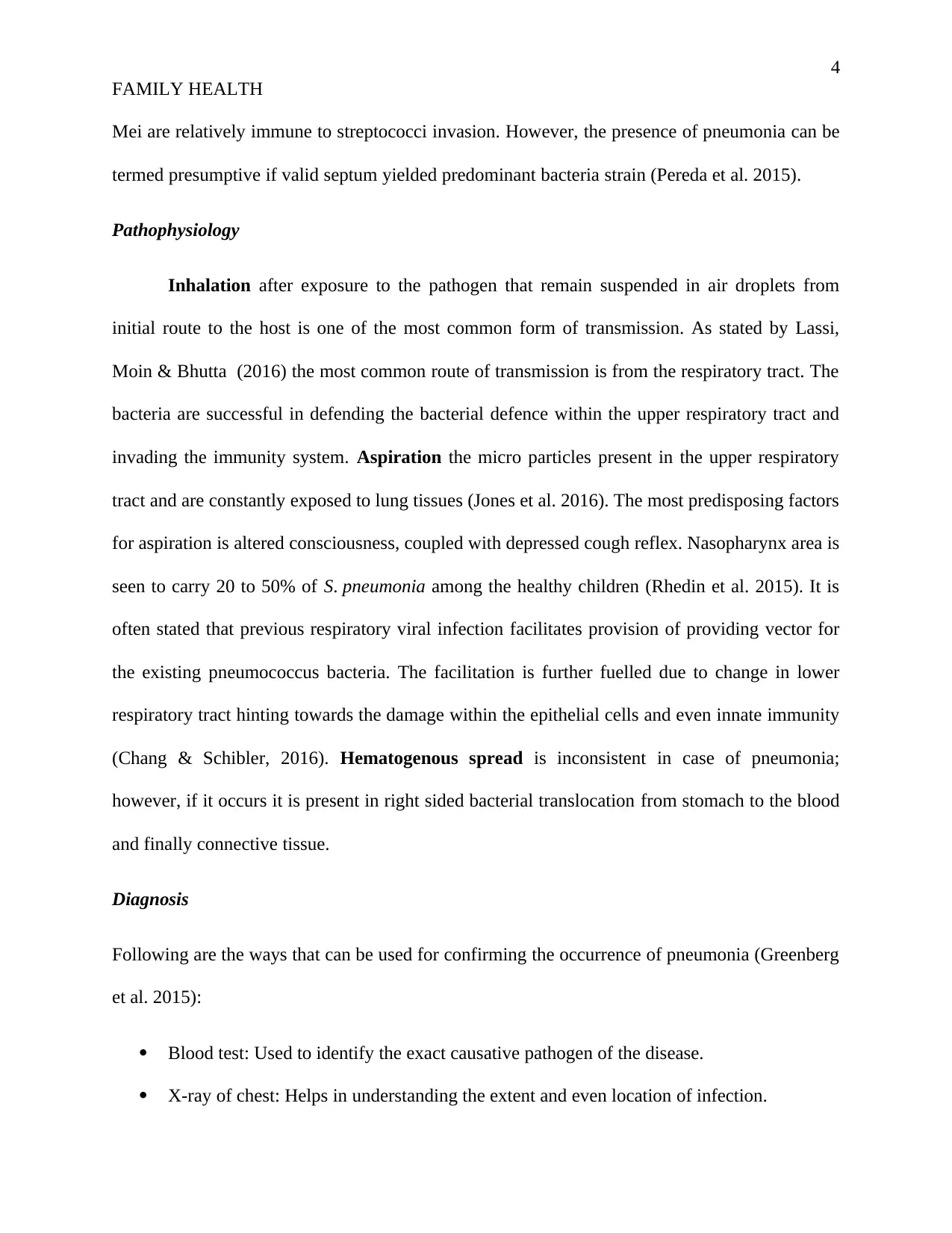
4
FAMILY HEALTH
Mei are relatively immune to streptococci invasion. However, the presence of pneumonia can be
termed presumptive if valid septum yielded predominant bacteria strain (Pereda et al. 2015).
Pathophysiology
Inhalation after exposure to the pathogen that remain suspended in air droplets from
initial route to the host is one of the most common form of transmission. As stated by Lassi,
Moin & Bhutta (2016) the most common route of transmission is from the respiratory tract. The
bacteria are successful in defending the bacterial defence within the upper respiratory tract and
invading the immunity system. Aspiration the micro particles present in the upper respiratory
tract and are constantly exposed to lung tissues (Jones et al. 2016). The most predisposing factors
for aspiration is altered consciousness, coupled with depressed cough reflex. Nasopharynx area is
seen to carry 20 to 50% of S. pneumonia among the healthy children (Rhedin et al. 2015). It is
often stated that previous respiratory viral infection facilitates provision of providing vector for
the existing pneumococcus bacteria. The facilitation is further fuelled due to change in lower
respiratory tract hinting towards the damage within the epithelial cells and even innate immunity
(Chang & Schibler, 2016). Hematogenous spread is inconsistent in case of pneumonia;
however, if it occurs it is present in right sided bacterial translocation from stomach to the blood
and finally connective tissue.
Diagnosis
Following are the ways that can be used for confirming the occurrence of pneumonia (Greenberg
et al. 2015):
Blood test: Used to identify the exact causative pathogen of the disease.
X-ray of chest: Helps in understanding the extent and even location of infection.
FAMILY HEALTH
Mei are relatively immune to streptococci invasion. However, the presence of pneumonia can be
termed presumptive if valid septum yielded predominant bacteria strain (Pereda et al. 2015).
Pathophysiology
Inhalation after exposure to the pathogen that remain suspended in air droplets from
initial route to the host is one of the most common form of transmission. As stated by Lassi,
Moin & Bhutta (2016) the most common route of transmission is from the respiratory tract. The
bacteria are successful in defending the bacterial defence within the upper respiratory tract and
invading the immunity system. Aspiration the micro particles present in the upper respiratory
tract and are constantly exposed to lung tissues (Jones et al. 2016). The most predisposing factors
for aspiration is altered consciousness, coupled with depressed cough reflex. Nasopharynx area is
seen to carry 20 to 50% of S. pneumonia among the healthy children (Rhedin et al. 2015). It is
often stated that previous respiratory viral infection facilitates provision of providing vector for
the existing pneumococcus bacteria. The facilitation is further fuelled due to change in lower
respiratory tract hinting towards the damage within the epithelial cells and even innate immunity
(Chang & Schibler, 2016). Hematogenous spread is inconsistent in case of pneumonia;
however, if it occurs it is present in right sided bacterial translocation from stomach to the blood
and finally connective tissue.
Diagnosis
Following are the ways that can be used for confirming the occurrence of pneumonia (Greenberg
et al. 2015):
Blood test: Used to identify the exact causative pathogen of the disease.
X-ray of chest: Helps in understanding the extent and even location of infection.
Paraphrase This Document
Need a fresh take? Get an instant paraphrase of this document with our AI Paraphraser
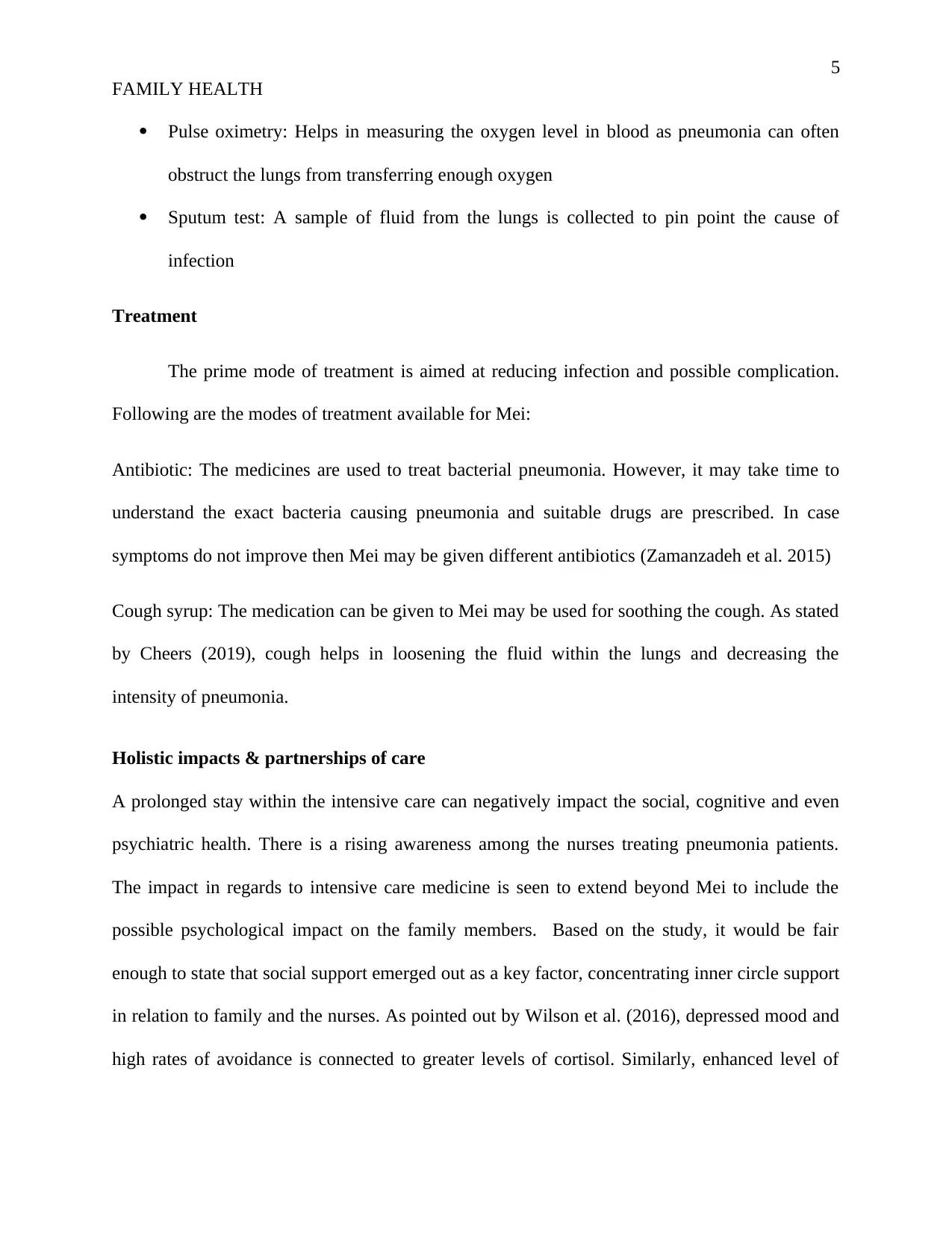
5
FAMILY HEALTH
Pulse oximetry: Helps in measuring the oxygen level in blood as pneumonia can often
obstruct the lungs from transferring enough oxygen
Sputum test: A sample of fluid from the lungs is collected to pin point the cause of
infection
Treatment
The prime mode of treatment is aimed at reducing infection and possible complication.
Following are the modes of treatment available for Mei:
Antibiotic: The medicines are used to treat bacterial pneumonia. However, it may take time to
understand the exact bacteria causing pneumonia and suitable drugs are prescribed. In case
symptoms do not improve then Mei may be given different antibiotics (Zamanzadeh et al. 2015)
Cough syrup: The medication can be given to Mei may be used for soothing the cough. As stated
by Cheers (2019), cough helps in loosening the fluid within the lungs and decreasing the
intensity of pneumonia.
Holistic impacts & partnerships of care
A prolonged stay within the intensive care can negatively impact the social, cognitive and even
psychiatric health. There is a rising awareness among the nurses treating pneumonia patients.
The impact in regards to intensive care medicine is seen to extend beyond Mei to include the
possible psychological impact on the family members. Based on the study, it would be fair
enough to state that social support emerged out as a key factor, concentrating inner circle support
in relation to family and the nurses. As pointed out by Wilson et al. (2016), depressed mood and
high rates of avoidance is connected to greater levels of cortisol. Similarly, enhanced level of
FAMILY HEALTH
Pulse oximetry: Helps in measuring the oxygen level in blood as pneumonia can often
obstruct the lungs from transferring enough oxygen
Sputum test: A sample of fluid from the lungs is collected to pin point the cause of
infection
Treatment
The prime mode of treatment is aimed at reducing infection and possible complication.
Following are the modes of treatment available for Mei:
Antibiotic: The medicines are used to treat bacterial pneumonia. However, it may take time to
understand the exact bacteria causing pneumonia and suitable drugs are prescribed. In case
symptoms do not improve then Mei may be given different antibiotics (Zamanzadeh et al. 2015)
Cough syrup: The medication can be given to Mei may be used for soothing the cough. As stated
by Cheers (2019), cough helps in loosening the fluid within the lungs and decreasing the
intensity of pneumonia.
Holistic impacts & partnerships of care
A prolonged stay within the intensive care can negatively impact the social, cognitive and even
psychiatric health. There is a rising awareness among the nurses treating pneumonia patients.
The impact in regards to intensive care medicine is seen to extend beyond Mei to include the
possible psychological impact on the family members. Based on the study, it would be fair
enough to state that social support emerged out as a key factor, concentrating inner circle support
in relation to family and the nurses. As pointed out by Wilson et al. (2016), depressed mood and
high rates of avoidance is connected to greater levels of cortisol. Similarly, enhanced level of
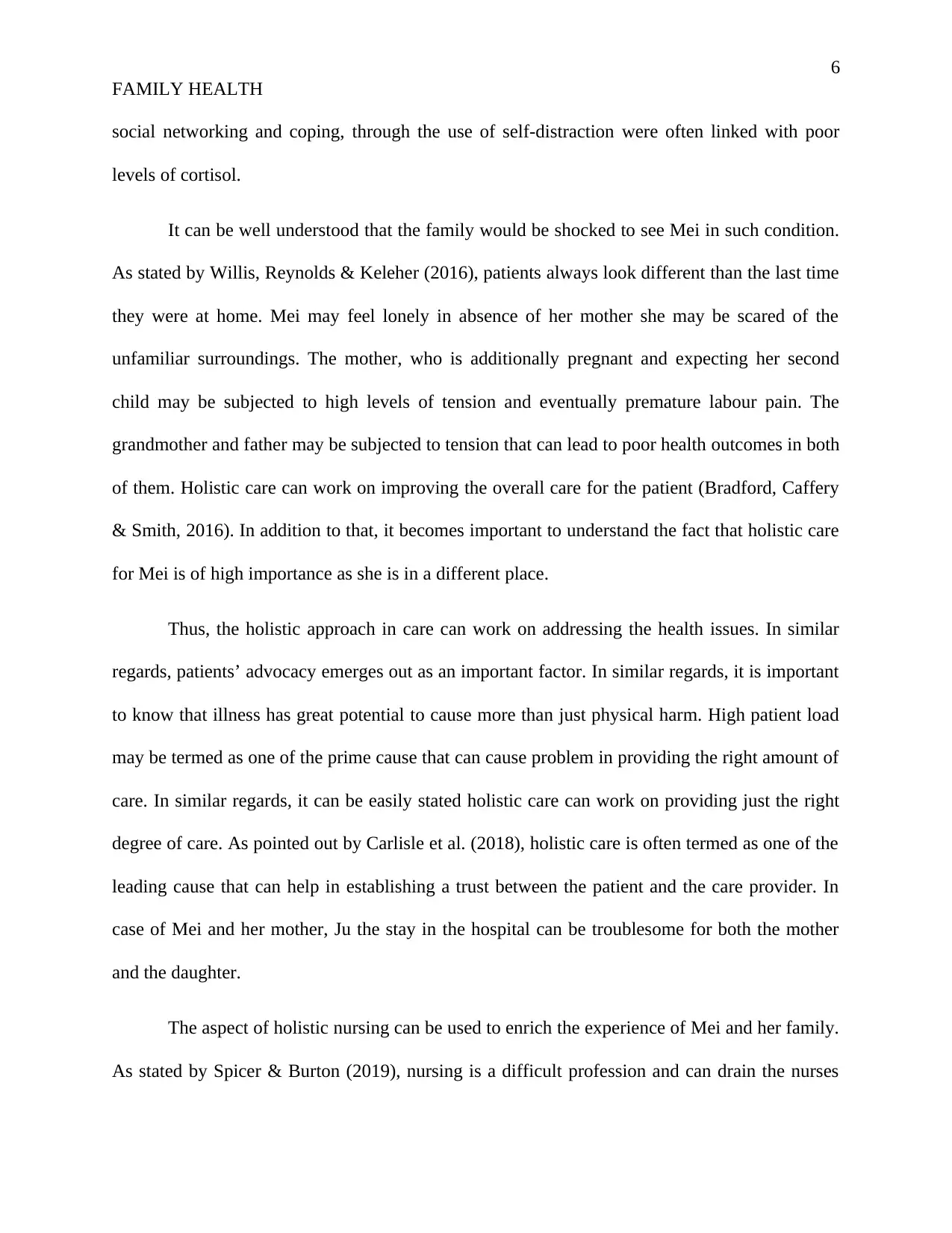
6
FAMILY HEALTH
social networking and coping, through the use of self-distraction were often linked with poor
levels of cortisol.
It can be well understood that the family would be shocked to see Mei in such condition.
As stated by Willis, Reynolds & Keleher (2016), patients always look different than the last time
they were at home. Mei may feel lonely in absence of her mother she may be scared of the
unfamiliar surroundings. The mother, who is additionally pregnant and expecting her second
child may be subjected to high levels of tension and eventually premature labour pain. The
grandmother and father may be subjected to tension that can lead to poor health outcomes in both
of them. Holistic care can work on improving the overall care for the patient (Bradford, Caffery
& Smith, 2016). In addition to that, it becomes important to understand the fact that holistic care
for Mei is of high importance as she is in a different place.
Thus, the holistic approach in care can work on addressing the health issues. In similar
regards, patients’ advocacy emerges out as an important factor. In similar regards, it is important
to know that illness has great potential to cause more than just physical harm. High patient load
may be termed as one of the prime cause that can cause problem in providing the right amount of
care. In similar regards, it can be easily stated holistic care can work on providing just the right
degree of care. As pointed out by Carlisle et al. (2018), holistic care is often termed as one of the
leading cause that can help in establishing a trust between the patient and the care provider. In
case of Mei and her mother, Ju the stay in the hospital can be troublesome for both the mother
and the daughter.
The aspect of holistic nursing can be used to enrich the experience of Mei and her family.
As stated by Spicer & Burton (2019), nursing is a difficult profession and can drain the nurses
FAMILY HEALTH
social networking and coping, through the use of self-distraction were often linked with poor
levels of cortisol.
It can be well understood that the family would be shocked to see Mei in such condition.
As stated by Willis, Reynolds & Keleher (2016), patients always look different than the last time
they were at home. Mei may feel lonely in absence of her mother she may be scared of the
unfamiliar surroundings. The mother, who is additionally pregnant and expecting her second
child may be subjected to high levels of tension and eventually premature labour pain. The
grandmother and father may be subjected to tension that can lead to poor health outcomes in both
of them. Holistic care can work on improving the overall care for the patient (Bradford, Caffery
& Smith, 2016). In addition to that, it becomes important to understand the fact that holistic care
for Mei is of high importance as she is in a different place.
Thus, the holistic approach in care can work on addressing the health issues. In similar
regards, patients’ advocacy emerges out as an important factor. In similar regards, it is important
to know that illness has great potential to cause more than just physical harm. High patient load
may be termed as one of the prime cause that can cause problem in providing the right amount of
care. In similar regards, it can be easily stated holistic care can work on providing just the right
degree of care. As pointed out by Carlisle et al. (2018), holistic care is often termed as one of the
leading cause that can help in establishing a trust between the patient and the care provider. In
case of Mei and her mother, Ju the stay in the hospital can be troublesome for both the mother
and the daughter.
The aspect of holistic nursing can be used to enrich the experience of Mei and her family.
As stated by Spicer & Burton (2019), nursing is a difficult profession and can drain the nurses
⊘ This is a preview!⊘
Do you want full access?
Subscribe today to unlock all pages.

Trusted by 1+ million students worldwide

7
FAMILY HEALTH
both physically and emotionally. The key is not that how long the nurse spends time with Mei or
her family, rather the quality of time matters the most.
Justification of holistic care and partnership
The family in the mentioned scenario is new to the scenario. Based on the case study, it
can be easily reflected that the family exhibits limited knowledge about the language. In addition
to that, Clark (2015), stated that the nurse’s intervention to ensure better scope of care is
important. The aspect of intervention plays important role in the mentioned case. The mentioned
case can work on providing a clear idea about the prospects of care needed by Mei or her family.
The philosophy of holistic care is based on the paradigms of humanistic view and unity. A
holistic paradigm is present in the current domains of healthcare and can be used for better
provision of care (Bing-Jonsson et al. 2016). There remains compelling evidence that most
nurses are well aware with biomedical and even allopathic focus are not in touch with the
concept of holistic care. In many countries the condition for care is not appropriate (Carlisle et al.
2018). The needs of patients are often forgotten and misunderstanding in relation to holistic care
is often forgotten. As pointed out by Bradford, Caffery & Smith (2016), the term holistic care is
often a subjective and even nebulous concept.
In general, holistic care works on describing the mental, physical and emotional needs. In
case of Mei it can be can be seen that she needs care for her physical condition as pneumonia can
take toll on her immunity and even her mood. The nurses should work on creating a scope of
care and provision of same for the patients (Wilson et al. 2016). In similar regards, it becomes
important to note the fact that her mental may be subjected to gradual degradation in absence of
her parents. Hence, it becomes equally important to understand the fact that Mei may be
subjected to emotional trauma due to isolation as measles may spread upon contact (Trent et al.
FAMILY HEALTH
both physically and emotionally. The key is not that how long the nurse spends time with Mei or
her family, rather the quality of time matters the most.
Justification of holistic care and partnership
The family in the mentioned scenario is new to the scenario. Based on the case study, it
can be easily reflected that the family exhibits limited knowledge about the language. In addition
to that, Clark (2015), stated that the nurse’s intervention to ensure better scope of care is
important. The aspect of intervention plays important role in the mentioned case. The mentioned
case can work on providing a clear idea about the prospects of care needed by Mei or her family.
The philosophy of holistic care is based on the paradigms of humanistic view and unity. A
holistic paradigm is present in the current domains of healthcare and can be used for better
provision of care (Bing-Jonsson et al. 2016). There remains compelling evidence that most
nurses are well aware with biomedical and even allopathic focus are not in touch with the
concept of holistic care. In many countries the condition for care is not appropriate (Carlisle et al.
2018). The needs of patients are often forgotten and misunderstanding in relation to holistic care
is often forgotten. As pointed out by Bradford, Caffery & Smith (2016), the term holistic care is
often a subjective and even nebulous concept.
In general, holistic care works on describing the mental, physical and emotional needs. In
case of Mei it can be can be seen that she needs care for her physical condition as pneumonia can
take toll on her immunity and even her mood. The nurses should work on creating a scope of
care and provision of same for the patients (Wilson et al. 2016). In similar regards, it becomes
important to note the fact that her mental may be subjected to gradual degradation in absence of
her parents. Hence, it becomes equally important to understand the fact that Mei may be
subjected to emotional trauma due to isolation as measles may spread upon contact (Trent et al.
Paraphrase This Document
Need a fresh take? Get an instant paraphrase of this document with our AI Paraphraser

8
FAMILY HEALTH
2016). However, the definition is not comprehensive and the concept of holistic. The meaning
related to holistic care is not comprehensive and works on demonstrating the concept of care
often used by the nurses with actual understanding.
Using the aspect of holistic care in the right way can help in understanding the therapeutic needs
of Mei increasing the knowledge of nurse and help in developing a framework for holistic care.
In addition to that, a comprehensive understanding about holistic care can further establish
professional autonomy that can facilitate application in regards to nursing practise, education and
even research.
Nursing activities and community resources
Embedded within the local community, nurses are often in a key position to encourage
people to make use of non-clinical services for better health outcomes. Research based study
provides enough idea pertaining to the fact that outdoor activities can help in enhancing the
mental health of the patient (Rhedin et al. 2015). Thus, it can be easily stated social prescribing
can be termed as one of the most prominent ways of addressing the challenge that makes use of
referral pathways for addressing the needs related to primary care for Mei. In case of Mei, things
may lead to progressive turn as her mother is expecting her second child. Mei may be subjected
to lack in attention towards her health as her mother may soon enter labour. Thus, the chosen
healthcare organization should help the chosen family by appointing a healthcare professional for
better health outcome for Mei and her mother. The community support can provide additional
help and work on addressing the health issues (June et al. 2016).
FAMILY HEALTH
2016). However, the definition is not comprehensive and the concept of holistic. The meaning
related to holistic care is not comprehensive and works on demonstrating the concept of care
often used by the nurses with actual understanding.
Using the aspect of holistic care in the right way can help in understanding the therapeutic needs
of Mei increasing the knowledge of nurse and help in developing a framework for holistic care.
In addition to that, a comprehensive understanding about holistic care can further establish
professional autonomy that can facilitate application in regards to nursing practise, education and
even research.
Nursing activities and community resources
Embedded within the local community, nurses are often in a key position to encourage
people to make use of non-clinical services for better health outcomes. Research based study
provides enough idea pertaining to the fact that outdoor activities can help in enhancing the
mental health of the patient (Rhedin et al. 2015). Thus, it can be easily stated social prescribing
can be termed as one of the most prominent ways of addressing the challenge that makes use of
referral pathways for addressing the needs related to primary care for Mei. In case of Mei, things
may lead to progressive turn as her mother is expecting her second child. Mei may be subjected
to lack in attention towards her health as her mother may soon enter labour. Thus, the chosen
healthcare organization should help the chosen family by appointing a healthcare professional for
better health outcome for Mei and her mother. The community support can provide additional
help and work on addressing the health issues (June et al. 2016).

9
FAMILY HEALTH
Conclusion
Based on the study, it can be clearly seen that the research highlights the importance of
community healthcare. Healthcare at community level is often termed as a holistic approach. The
community based services can be used to make sure that the health needs are met. Thus, it
becomes important to reach out to community health services. In similar regards, health of one
member in the family can ensure positive health outcome at all levels
FAMILY HEALTH
Conclusion
Based on the study, it can be clearly seen that the research highlights the importance of
community healthcare. Healthcare at community level is often termed as a holistic approach. The
community based services can be used to make sure that the health needs are met. Thus, it
becomes important to reach out to community health services. In similar regards, health of one
member in the family can ensure positive health outcome at all levels
⊘ This is a preview!⊘
Do you want full access?
Subscribe today to unlock all pages.

Trusted by 1+ million students worldwide
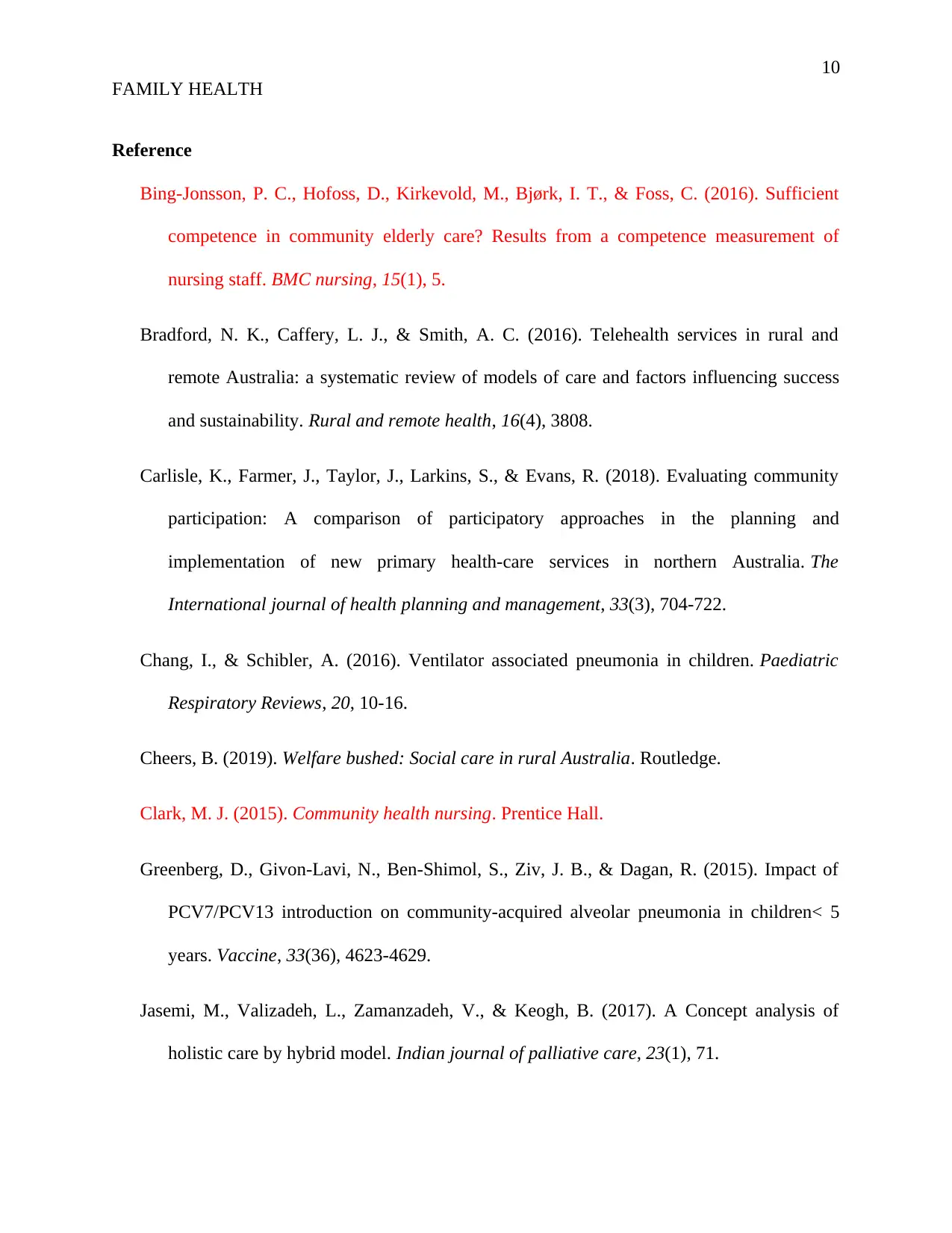
10
FAMILY HEALTH
Reference
Bing-Jonsson, P. C., Hofoss, D., Kirkevold, M., Bjørk, I. T., & Foss, C. (2016). Sufficient
competence in community elderly care? Results from a competence measurement of
nursing staff. BMC nursing, 15(1), 5.
Bradford, N. K., Caffery, L. J., & Smith, A. C. (2016). Telehealth services in rural and
remote Australia: a systematic review of models of care and factors influencing success
and sustainability. Rural and remote health, 16(4), 3808.
Carlisle, K., Farmer, J., Taylor, J., Larkins, S., & Evans, R. (2018). Evaluating community
participation: A comparison of participatory approaches in the planning and
implementation of new primary health‐care services in northern Australia. The
International journal of health planning and management, 33(3), 704-722.
Chang, I., & Schibler, A. (2016). Ventilator associated pneumonia in children. Paediatric
Respiratory Reviews, 20, 10-16.
Cheers, B. (2019). Welfare bushed: Social care in rural Australia. Routledge.
Clark, M. J. (2015). Community health nursing. Prentice Hall.
Greenberg, D., Givon-Lavi, N., Ben-Shimol, S., Ziv, J. B., & Dagan, R. (2015). Impact of
PCV7/PCV13 introduction on community-acquired alveolar pneumonia in children< 5
years. Vaccine, 33(36), 4623-4629.
Jasemi, M., Valizadeh, L., Zamanzadeh, V., & Keogh, B. (2017). A Concept analysis of
holistic care by hybrid model. Indian journal of palliative care, 23(1), 71.
FAMILY HEALTH
Reference
Bing-Jonsson, P. C., Hofoss, D., Kirkevold, M., Bjørk, I. T., & Foss, C. (2016). Sufficient
competence in community elderly care? Results from a competence measurement of
nursing staff. BMC nursing, 15(1), 5.
Bradford, N. K., Caffery, L. J., & Smith, A. C. (2016). Telehealth services in rural and
remote Australia: a systematic review of models of care and factors influencing success
and sustainability. Rural and remote health, 16(4), 3808.
Carlisle, K., Farmer, J., Taylor, J., Larkins, S., & Evans, R. (2018). Evaluating community
participation: A comparison of participatory approaches in the planning and
implementation of new primary health‐care services in northern Australia. The
International journal of health planning and management, 33(3), 704-722.
Chang, I., & Schibler, A. (2016). Ventilator associated pneumonia in children. Paediatric
Respiratory Reviews, 20, 10-16.
Cheers, B. (2019). Welfare bushed: Social care in rural Australia. Routledge.
Clark, M. J. (2015). Community health nursing. Prentice Hall.
Greenberg, D., Givon-Lavi, N., Ben-Shimol, S., Ziv, J. B., & Dagan, R. (2015). Impact of
PCV7/PCV13 introduction on community-acquired alveolar pneumonia in children< 5
years. Vaccine, 33(36), 4623-4629.
Jasemi, M., Valizadeh, L., Zamanzadeh, V., & Keogh, B. (2017). A Concept analysis of
holistic care by hybrid model. Indian journal of palliative care, 23(1), 71.
Paraphrase This Document
Need a fresh take? Get an instant paraphrase of this document with our AI Paraphraser
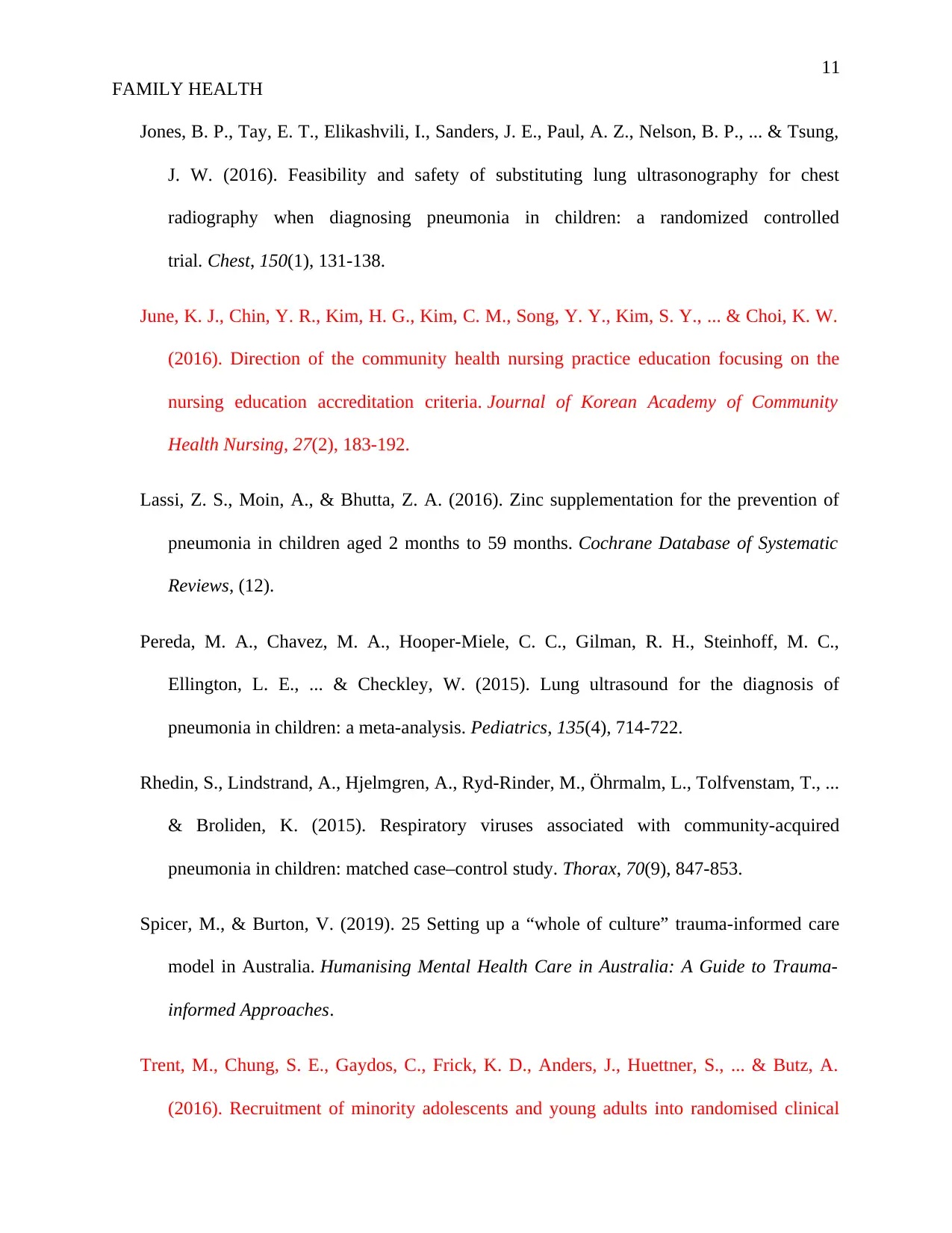
11
FAMILY HEALTH
Jones, B. P., Tay, E. T., Elikashvili, I., Sanders, J. E., Paul, A. Z., Nelson, B. P., ... & Tsung,
J. W. (2016). Feasibility and safety of substituting lung ultrasonography for chest
radiography when diagnosing pneumonia in children: a randomized controlled
trial. Chest, 150(1), 131-138.
June, K. J., Chin, Y. R., Kim, H. G., Kim, C. M., Song, Y. Y., Kim, S. Y., ... & Choi, K. W.
(2016). Direction of the community health nursing practice education focusing on the
nursing education accreditation criteria. Journal of Korean Academy of Community
Health Nursing, 27(2), 183-192.
Lassi, Z. S., Moin, A., & Bhutta, Z. A. (2016). Zinc supplementation for the prevention of
pneumonia in children aged 2 months to 59 months. Cochrane Database of Systematic
Reviews, (12).
Pereda, M. A., Chavez, M. A., Hooper-Miele, C. C., Gilman, R. H., Steinhoff, M. C.,
Ellington, L. E., ... & Checkley, W. (2015). Lung ultrasound for the diagnosis of
pneumonia in children: a meta-analysis. Pediatrics, 135(4), 714-722.
Rhedin, S., Lindstrand, A., Hjelmgren, A., Ryd-Rinder, M., Öhrmalm, L., Tolfvenstam, T., ...
& Broliden, K. (2015). Respiratory viruses associated with community-acquired
pneumonia in children: matched case–control study. Thorax, 70(9), 847-853.
Spicer, M., & Burton, V. (2019). 25 Setting up a “whole of culture” trauma-informed care
model in Australia. Humanising Mental Health Care in Australia: A Guide to Trauma-
informed Approaches.
Trent, M., Chung, S. E., Gaydos, C., Frick, K. D., Anders, J., Huettner, S., ... & Butz, A.
(2016). Recruitment of minority adolescents and young adults into randomised clinical
FAMILY HEALTH
Jones, B. P., Tay, E. T., Elikashvili, I., Sanders, J. E., Paul, A. Z., Nelson, B. P., ... & Tsung,
J. W. (2016). Feasibility and safety of substituting lung ultrasonography for chest
radiography when diagnosing pneumonia in children: a randomized controlled
trial. Chest, 150(1), 131-138.
June, K. J., Chin, Y. R., Kim, H. G., Kim, C. M., Song, Y. Y., Kim, S. Y., ... & Choi, K. W.
(2016). Direction of the community health nursing practice education focusing on the
nursing education accreditation criteria. Journal of Korean Academy of Community
Health Nursing, 27(2), 183-192.
Lassi, Z. S., Moin, A., & Bhutta, Z. A. (2016). Zinc supplementation for the prevention of
pneumonia in children aged 2 months to 59 months. Cochrane Database of Systematic
Reviews, (12).
Pereda, M. A., Chavez, M. A., Hooper-Miele, C. C., Gilman, R. H., Steinhoff, M. C.,
Ellington, L. E., ... & Checkley, W. (2015). Lung ultrasound for the diagnosis of
pneumonia in children: a meta-analysis. Pediatrics, 135(4), 714-722.
Rhedin, S., Lindstrand, A., Hjelmgren, A., Ryd-Rinder, M., Öhrmalm, L., Tolfvenstam, T., ...
& Broliden, K. (2015). Respiratory viruses associated with community-acquired
pneumonia in children: matched case–control study. Thorax, 70(9), 847-853.
Spicer, M., & Burton, V. (2019). 25 Setting up a “whole of culture” trauma-informed care
model in Australia. Humanising Mental Health Care in Australia: A Guide to Trauma-
informed Approaches.
Trent, M., Chung, S. E., Gaydos, C., Frick, K. D., Anders, J., Huettner, S., ... & Butz, A.
(2016). Recruitment of minority adolescents and young adults into randomised clinical

12
FAMILY HEALTH
trials: Testing the design of the technology enhanced community health nursing (tech-n)
pelvic inflammatory disease trial. European Medical Journal. Reproductive health, 2(1),
41.
Willis, E., Reynolds, L., & Keleher, H. (Eds.). (2016). Understanding the Australian health
care system. Elsevier Health Sciences.
Wilson, L. K., Coombs, G. W., Christiansen, K., Grubb, W. B., & O'Brien, F. G. (2016).
Characterization of a novel staphylococcal cassette chromosome composite island from
community-associated MRSA isolated in aged care facilities in Western
Australia. Journal of Antimicrobial Chemotherapy, 71(12), 3372-3375.
Zamanzadeh, V., Jasemi, M., Valizadeh, L., Keogh, B., & Taleghani, F. (2015). Effective
factors in providing holistic care: A qualitative study. Indian journal of palliative
care, 21(2), 214.
FAMILY HEALTH
trials: Testing the design of the technology enhanced community health nursing (tech-n)
pelvic inflammatory disease trial. European Medical Journal. Reproductive health, 2(1),
41.
Willis, E., Reynolds, L., & Keleher, H. (Eds.). (2016). Understanding the Australian health
care system. Elsevier Health Sciences.
Wilson, L. K., Coombs, G. W., Christiansen, K., Grubb, W. B., & O'Brien, F. G. (2016).
Characterization of a novel staphylococcal cassette chromosome composite island from
community-associated MRSA isolated in aged care facilities in Western
Australia. Journal of Antimicrobial Chemotherapy, 71(12), 3372-3375.
Zamanzadeh, V., Jasemi, M., Valizadeh, L., Keogh, B., & Taleghani, F. (2015). Effective
factors in providing holistic care: A qualitative study. Indian journal of palliative
care, 21(2), 214.
⊘ This is a preview!⊘
Do you want full access?
Subscribe today to unlock all pages.

Trusted by 1+ million students worldwide
1 out of 12
Related Documents
Your All-in-One AI-Powered Toolkit for Academic Success.
+13062052269
info@desklib.com
Available 24*7 on WhatsApp / Email
![[object Object]](/_next/static/media/star-bottom.7253800d.svg)
Unlock your academic potential
Copyright © 2020–2025 A2Z Services. All Rights Reserved. Developed and managed by ZUCOL.



